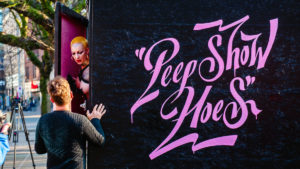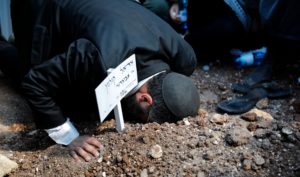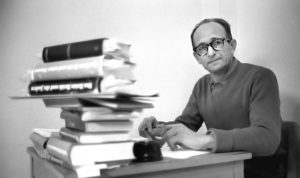Embedded in the cobbled pavements of the Netherlands are thousands of brass memorial plaques dedicated to victims of the Nazi genocide: stumbling stones, or Stolplersteine. “As you stumble over them, you stumble over the past,” writes Rosemary Sullivan. “It is part of the fabric of the present.”
With this image, Sullivan ends her book, The Betrayal of Anne Frank: A Cold Case Investigation. Her subtitle, less a mystery unsolved than a secret well kept, trails the book’s bombshell: that a Jewish Council member, Arnold van den Bergh, was in their view “the betrayer”.
It took five years, a €100,000 public subsidy, cutting edge artificial intelligence and a retired FBI special agent, Vince Pankoke, to reach this conclusion — which was launched less than a month ago by an international publishing machine. Sullivan outlines the theory of the Cold Case Diary team: that Van den Bergh “saved his family by giving up addresses, including Prinsengracht 163, to the SD”.
The team described itself as “confident” of this conclusion, which was based on an anonymous note sent to Otto Frank, the only member of the family who survived two years hiding from the Nazis in The Secret Annex. But the global publicity campaign, promoting the idea that it was a Jewish man who betrayed the Franks, unleashed a wave of criticism.
Some scholars and historians immediately questioned the claim, sources distanced themselves, the Dutch publisher Ambo Anthos apologised for any offence caused and paused distribution, influential German magazine Die Zeit accused Sullivan of “sensationalism”, and the heads of the Anne Frank House in Amsterdam and Anne Frank Fonds in Basel expressed doubts about the work. The team fiercely defended their conclusions in their blog. But they did backpedal on earlier interviews, in which they had stated that there was an “85% probability” that they were correct, saying this was not an 85% certainty but a “conditional probability”.
While the book predicts a strong reaction to its “powerful” and “unsettling” conclusions — which are presented like a “true crime” documentary and with the certainty of a court verdict — the team has apparently been surprised and shocked by the backlash. They feel like victims of a kind of witch hunt.
The Dutch wounds of Nazi occupation are clearly so close to the surface that, at a scratch, they still bleed. The Netherlands has the worst record of Jewish deaths in Western Europe: an estimated 73% of the Jewish population died. Professor Frank van Vree — a researcher at the NIOD Institute for War, Holocaust and Genocide Studies — points out that Remembrance Day on 4 May was named one of the most important national unifiers in a recent, wide-ranging study by the Netherlands Institute for Social Research.
But just as the Dutch self-image of a tolerant, open society has been challenged by admissions of systemic racism, looking closely at the reality of the Holocaust reveals some uncomfortable truths. “From the mid-Sixties, the story of the destruction of Dutch Jewry and the complicity of the non-Jewish Dutch is a permanent struggle with the rosy Dutch self-image,” says Van Vree. “The knowledge that this really happened… in a society that considered itself a haven of tolerance… It never disappeared, this feeling of guilt”.
And the story of Anne Frank brings a lot of these tensions to the surface. After it was published in 1947 (and with the 1955 Broadway play that brought it to American attention), the diary weathered claims that it was fake, as well as initial hesitancy from international publishers to make Anne Frank, as some historians have it, the centrepiece of Holocaust memorial.
Her story is also perfectly designed for a global audience. “She comes from a very humanist, Frankfurt-based family; she counts as one of the famous Dutch but in reality she’s German,” says Johannes Houwink ten Cate, emeritus professor and chair of Holocaust and Genocide Studies at the University of Amsterdam. “And the way Judaism was practised in the Anne Frank family comes very close to the American reform tradition.
“Anne Frank is ideal for identification,” he goes on. “She keeps her faith in humanity, she has all the dreams 13-year-old girls have”. And we fulfil Anne’s dream of becoming a writer by the positive act of reading. “The Anne Frank diary has become a sort of mirror of our society”.
There’s one conspicuous absence in the book, though. “Anne Frank is of course the most famous Holocaust victim”, says ten Cate, “because her book is not about the Holocaust”. The diary ends abruptly; we know where she went, and what happened to her. But “the Holocaust is not mentioned in the book.” The great question the reader is left with is: who betrayed her?
Past theories include warehouse worker Willem van Maaren, Dutch national socialist Tonny Ahlers, famous “Jew-hunter” Ans van Dijk, and a bureaucratic investigation into food stamp fraud. But while ever more books come out to present a new villain to counter Anne Frank’s heroism, the truth of the Dutch war experience was different: collaborating with the Nazis was not the occasional act of the rare individual.
The Netherlands suffered military defeat in five days. There is evidence of sustained civil service and economic collaboration with Nazism after this — the state railway company, for instance, recently agreed to pay €50m in compensation for transporting people to Nazi camps. The population, meanwhile, mostly kept its head down. But many police and civilians betrayed Jewish people in hiding and received financial rewards: kopgeld or “head bounty” (Pankoke, the retired special agent, discovered a microfilm of 956 kopgeld receipts in an American archive).
Solidarity with Jewish people was greater in France and Belgium, which had experience of resistance movements, and where the Germans did not institute a civilian government. The geography there also made hiding easier.
But after the war, the Dutch popular narrative did not recognise that particular groups had suffered more. Stories of the treatment received by Jewish people returning from the camps are appalling: they were given no preferential state help, and sometimes found their possessions taken by other citizens not keen to return them. They even faced housing tax bills for the time when they were imprisoned by Nazis.
Perhaps it’s unsurprising, then, that the Protestant Church in 2020 declared its sense of guilt for failing to protect the Jewish population. That year, Dutch king Willem-Alexander said in his Remembrance Day speech that his great-grandmother Queen Wilhelmina — while in exile in London — did not do enough to support the Jewish community, even “if only by words”.
But it’s very late in the day to recognise some of these injustices. When, in 2016, Amsterdam announced a €10m payment to Holocaust survivors for taxing them while they were in the camps, there were not enough of them left to take it, and the money was instead given to Jewish-related causes.
Meanwhile, after years of examining the cases of museums exhibiting art looted by the Nazis, Dutch restitutions policy has only just been changed to show “more humanity and goodwill”. This year, Amsterdam’s Stedelijk Museum is expected to hand back a Kandinsky painting, considered a “forced sale”, to the Jewish heirs. Other claim cases are still rumbling.
During this moment of reckoning, the aim of the Cold Case Diary team was, to quote Pankoke, to “provide some closure to the descendants of those who were captured”. But the fact that it points the finger at a Jewish man has been a source of much controversy. Van Vree feels this kind of conclusion should only be made when it is beyond any reasonable doubt. “That’s the last thing that you should suggest — only at the very end, if you are absolutely sure about it”, he says. “The critics are almost all people who are very aware of the non-Jewish guilt about what happened. This is very improper, and if you accept it, you might imply that actually the non-Jews are innocent, so to speak”.
For relatives of Van den Burgh, including his great-niece Elise Tak, the accusation is “appalling”. She questions the proof that any list of hiding places existed, and where the accusatory, anonymous note sent to Otto Frank came from.
Meanwhile the Dutch population is left wondering how to feel about the behaviour of its ancestors. Which is ironic, given that the filmmaker Thijs Bayens started the “cold case” project to try to understand what happens to a population if life is “threaded with fear”.
“The truth never is about the past — it always is about us,” says ten Cate, who expects to see another four or five ‘betrayers’ named in his lifetime. “If it’s only about the past, we don’t give a damn. Historians … isolate particular facts and events from the past and bring them into focus because we want to re-form them to something that is relevant for our own identity. Often it takes the form: what would I have done and what exactly is the relation between us, our identity, our self-image, and what happened in the past? Are we entitled to have a better self-image than our parents?”
Whatever your answer, and whatever you think of Sullivan’s book and the team’s conclusions, we have to confront the facts. Reparations can still be made, especially while there are survivors. “It is important to have these conversations now,” he says. “Belated justice is justice.” And even after attempts at justice, it is important to remember, and to trip over, the painful stumbling stones of the past.
Disclaimer
Some of the posts we share are controversial and we do not necessarily agree with them in the whole extend. Sometimes we agree with the content or part of it but we do not agree with the narration or language. Nevertheless we find them somehow interesting, valuable and/or informative or we share them, because we strongly believe in freedom of speech, free press and journalism. We strongly encourage you to have a critical approach to all the content, do your own research and analysis to build your own opinion.
We would be glad to have your feedback.
Source: UnHerd Read the original article here: https://unherd.com






